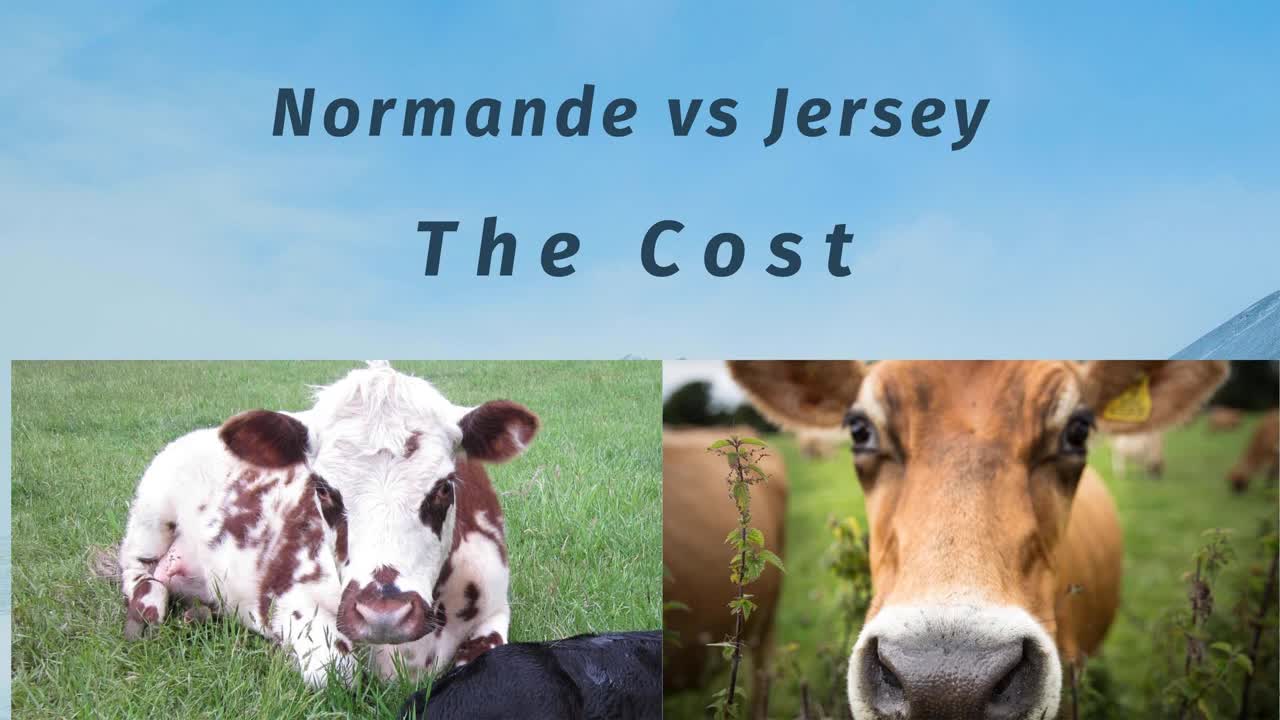Premium Only Content

Normande vs Jersey
We have made some really startling discoveries lately regarding the cost of milking cows and I want to share that with you today. Normande vs Jersey – the cost is the main topic for today. Both are traditional breeds. What’s the difference and how does that affect the cost of raising them.
Today’s Show
• Homestead Life Updates
• Normande vs Jersey – The Cost
• Skillet Chicken with Neufchatel Spinach Artichoke Sauce
Homestead Life Updates
Life is getting back to normal on the homestead. I’m mending nicely and my energy level is back to where I can work all day and not be too tired. I still have to watch myself in the heat and doing too much in one day. While I’m active all day, I want to be cognizant of the strength and energy required to perform those activities. For instance, I might go to the garden for a little while, but not for the hours and hours I would put in before. I do more inside tasks.
The Garden
Speaking of the garden, putting in less hours is working out well as the garden is winding down. We have finished with the tomatoes. Not because they weren’t producing but because I simply have had enough of tomatoes. I planted way too many. If it weren’t for the drought we have been experiencing, I would have been even more overwhelmed. Most of the season the tomatoes were small due to lack of water and fertilizer. They were very good tomatoes, just not very big. Instead of a nice 3 ½ inch diameter, they were more like 2 ½ inches in diameter. Pretty small I know. But they were really, really good.
The Many Ways of Preserving Tomatoes
I’ve canned and canned and canned. Mostly tomato sauce, though I made a few jars of salsa and really like it. I have all of the remaining tomatoes on a shelf inside the house near a window. Those tomatoes will all go into salsa. Barbecue sauce is on the list as well. That concoction is just about ready to be canned. Even though I am using a traditional recipe it calls for more sugar than I want. I can leave out some of the sugar and start my own traditional barbeque sauce line as a much healthier product. IMO
Animal Husbandry
The animals are doing really well. We had a long discussion about where we are going to go with our animals. We currently have sheep, goats, cows, and donkeys. Which do we want to keep and which will go? We haven’t talked much about the donkeys, though we have discussed selling two of them as we don’t need that many. And after I talk about the sheep, we may not need any at all. That is another discussion.
The Sheep
Currently we have one breeding ram and 6 ewes. This year that combination produced 10 lambs that will go to market next year. We also have three lambs that are ready for market right now. Get your orders in now if you want a half or whole lamb. Again, there are only three.
We had a good long discussion about the sheep a few days ago. They are wonderful animals and very easy to keep and manage. The flock has been genetically improved so they have little to no problems with parasites. That was a big problem for us in the beginning. We lost many animals – especially small lambs – in the first year or two.
The discussion revolved around time management. While they are easy to keep and raise, they also are one more marketing task that we have to take on to sell the lambs and meat each year. In our neck of the woods, lamb is actually quite popular. However, every minute I spend marketing lamb is a minute I don’t spend marketing cheese. These are business decisions that have to be considered.
In the end, we decided to phase out our flock of sheep. We will not breed this year and will begin culling the older ewes a little at a time. Likely we will sell the breeding ram, but in the end, all sheep will be gone from our homestead. At least for the time being. We can revisit this after the creamery is completed and we have a good handle on making and marketing our cheese. For right now, the creamery, cheesemaking and marketing are our primary focus.
The Purpose of Goats
Unlike the sheep, the goats have a greater role to play in the maintenance of good pasture for our grass-fed operation. Sheep do eat different things than cows initially, but in the end, they both eat all of the grasses. The goats, on the other hand, like to eat woody stems such as small trees, briars, brambles, wild blackberries and so on. But still there will be changes. Again, relating to efficient time management on the homestead.
We chose cashmere goats because I love to knit. It was a great idea to raise them, comb out the cashmere, then send it off to be processed and spun into roving and yarn. Then I was going to knit cute little baby stuff to sell at the market. In the end, I simply don’t have that kind of time. There is only so much I can do. This is a great life lesson. You can divide your focus between two things, but neither will ever get your full attention.
The goats require constant hoof maintenance. The cashmere must be combed out at exactly the right time in late winter. There is a pre-cleaning that happens before sending it off to be cleaned, carded and made into roving and/or yarn. I once thought that I would have lots of time in the winter to sit and knit to my heart’s content. Didn’t happen.
I spend a great deal of time in the winter laying out the marketing plans for the spring, summer and fall. Because once spring has sprung, everything else goes on hold. Cows are being milked, cheese is being made, and trips to the farmer’s market are happening a couple of times a week. I better have all of my marketing ducks in a row before the dam bursts.
What To Do With Our Goats
Back to the goats. We will still have a herd of goats. However, we are going to cull out all of the cashmere goats and eventually bring in some Kiko goats. Kikos were developed in New Zealand based on the needs of the local markets. They needed goats that did not require a lot of parasite control and certainly did not need hoof maintenance. Taking a feral breed and crossing it with domestic breeds, they were able to develop a great meat goat that requires little to no maintenance. That’s our kind of animal. We still have to sell the goat meat, but we will keep the herd small.
We haven’t managed our goats nearly as well as the sheep. Unauthorized breeding is an ongoing problem with them. There seem to be goat kids popping out at the most inconvenient times. And of course, it makes the herd bigger when we don’t take the time to get them to market. Unlike the Kiko goat which was developed for efficient meat production, the cashmere goats take a long time to get to a good size for market. They are bred for their winter undercoat of cashmere with no regard for any other trait.
The Donkeys
As I mentioned, we haven’t discussed the donkeys and whether we will continue to keep them after the sheep are gone. They were purchased as livestock guardian animals for the sheep. They are also the only thing on the homestead that could properly be called a pet. They are very friendly animals and they crave human interaction.
Likely we will keep them around. We want you guys to come visit us and I wouldn’t want you to miss them. AAANNNDDD I would miss them too.
The Cows
Finally, I get to the cows and this will lead into today’s topic. In fact, I’m going to skip right to the topic.
Normande vs Jersey Cows – the Cost Analysis
First, a short review of our choice for the Normande breed of cow. Second, how did we end up with a Jersey cow and heifer calf? Lastly, how has this experience changed the way we think about our herd?
Why We Chose Normande Cows?
I know you’ve heard me say this before, but I’ll say it again. I love our Normande cows. For more particulars about the breed, listen to my podcast “Why Normande Cows”. We bought our first girls in the fall of 2011. There was never any doubt in my mind that I would have a milk cow on our homestead. Making cheese, butter and yogurt along with that luscious fresh milk straight from the cow was on the top of my list of things I wanted in my life.
We had plenty of time to research what kind of cow we wanted to have for our traditional family cow. As mentioned above, there are always offspring to deal with when raising animals. In order for a cow to produce milk, she needs to have a calf every year. She will produce milk for about a year before naturally drying up, but proper management requires us to stop milking her and “dry her off” a good three months before she gives birth again. That gives her the resources she needs to remain healthy and grow a healthy calf. So what kind of cow was going to give us a good calf for beef as well as produce a lot of milk for my enjoyment, cheesemaking and so on?
Dual Breed Cows
There are quite a few breeds that are listed as “dual breed”, meaning they produce lots of milk but also produce calves that grow out with well-marbled meat in a timely manner. Another requirement we had was a good healthy steer that could thrive on pasture and did not need to be grain finished to reach that well-marbled meat in a timely manner goal. Same for the milk. She needs to be able to maintain her weight and condition without being fed the customary 6 pounds of grain a day allowed for organic grass-fed dairies. Commercial dairies will feed their cows up to 30 pounds of grain per day.
The trade off with not feeding grain is less milk. Grain definitely increases milk production. And while I am not opposed to feeding the 6 pounds of non-gmo, non-soy feed, if we need more production, our current model does not require this. Let me explain a little more.
My first concern is the health of the cow. I’ve seen some pretty skinny milk cows. They were being pasture raised with absolutely no grain. It’s a fine goal, but if your cow is starving because so much of her energy is going into milk production that there is little left for her own needs, the goal is flawed. I prefer a system approach.
My system is designed to keep healthy herd, produce enough milk for us to make our traditional, hand-made artisan cheese in sufficient quantity to support the homestead, and produce excellent beef, breeding and replacement stock with the annual calving.
There are several breeds that advertise themselves as fitting those requirements. But the Normande stood out in my mind. Their milk production is on par with the Jersey. The fat and protein components are on par with the Jersey. The largest deciding factor was the composition of the milk as it relates to cheesemaking.
Normande Cow Characteristics
The Normande cow produces a milk with a protein structure that is the most conducive to cheesemaking. In France, Normande milk is prized and even required for some cheeses to carry a specific name. Camembert di Normande comes to mind. Neufchâtel is also made with milk from Normande cows. Neufchatel is a traditional, soft-white, table cheese, originating from the village of Neufchatel-en-Bray in northern Normandy. It is one of France’s oldest cheese, dating back as far as 1035. Often, it is heart-shaped. That shape came about during the Hundred Years’ War between England and France from 1337 to 1453. Tales are told about the French farm girls falling in love with English soldiers and making these heart-shaped cheese to show their love.
One other characteristic we considered was docility. Cows are very large animals. I wanted a breed that was gentle and easy to work with and the Normande has exceeded my expectations in that area. Far exceeded my expectations.
We love our Normandes so how did we come to own a couple of Jerseys?
Why Did We Buy a Jersey Cow?
I often referred to Jersey cows when talking about the Normande and other dairy breeds. It is the most popular choice for a family milk cow. Typically, they produce lots and lots of milk with higher butterfat and protein levels than other breeds. They are not, however, a dual breed. They are actually quite skinny in their natural state. Boney in fact. While our Normandes are flat across their rump with meat and fat, the Jersey cow’s hip bones are really prominent. It is how they are genetically built. Their energy primarily goes into making milk, not meat and fat.
Jersey milk is highly prized for the highest butter fat content. That means you can make lots of butter. Cheese made from Jersey milk will also be higher in fat, and that means more flavor. They are a great milk cow. But again, not a dual breed. Though I do see a lot of marketing going on right now for Jersey beef. And I assure you, that it is only marketing. It is marketing with information put together by the American Jersey Cattle Association researchers. The studies they are conducting include the standard grain diet fed to beef cattle to grow out the Jersey steers. They are simply not going to get the proper level of fat on grass only. I think it might work for the commercial market, but would not be viable for the family homestead. I’m willing to change my mind if I’m wrong. Right now, my mind says that Jerseys are NOT a dual breed.
So how did we end up with a bred Jersey cow? We needed some cash flow and herd shares were one way to provide it. A combination of the A2A2 certification of this cow and her calf along with the possibility of an existing customer base tipped the scale.
When I was first approached, I simply wasn’t interested in another cow – and a Jersey to boot. But the idea of offering herd shares was intriguing. After a few days and lots of discussion, Scott and I decided to give it a try. It was a big financial risk but we decided to take the plunge. The current owner was offering herd shares and some of her customers would likely come to us after she stopped offering the service. That would help offset the initial cost of the cow. Additionally, I felt I could work it into my already busy marketing schedule as the herd shares contributed to our cheese centerpiece. Yes, we offer the fresh raw milk, but we also provide cheese, yogurt and butter to our herd share owners.
Fast forward, Butter has her calf. A very beautiful deer-like heifer. Very boney and much smaller than our Normande calves. That’s just how they come. We started milking Butter and offering fresh A2A2 milk via our herd shares. The legal contracts are worded to include cheese, butter, yogurt and cream as part of the herd production.
Here’s What We Found Out – the Good News
The A2A2 milk is the real draw for both the milk and the cheese. We are in the process of getting our Normande cows tested for the A2A2 beta casein genetic trait. For more info on that, listen to my podcast, “What is A2A2 Milk?” Link in the show description. We are moving our herd genetics to 100% A2A2 beta casein and BB kappa casein. I haven’t talked about kappa casein yet. BB kappa casein is the genetic quality that makes the best cheese. That need its own podcast.
Here’s What We Found Out – the Bad News
First, the docility factor. Jerseys, and indeed most dairy cows, are fairly placid. What I see is that they are placid with humans. The Jersey cows are very aggressive with the other cows. Even Egwene, Butter’s calf, is aggressive with her bottle. She pushes and jerks on that bottle with ferocity. It’s not a problem for us at all. Just noted. As I said, the Jersey cows are very placid with humans.
Second, that Jersey does produce some really good milk and cream. She also requires feed – expensive feed. While our Normande cows stay fat and healthy on pure grass, even when they are in milk, a Jersey requires feed to maintain body condition when in milk. We feed a little bit of a supplement to our Normandes purely to keep them interested in coming into the milking parlor. Violet in particular is quite fat and she never received any grain supplement until this year when we trained her to put her head into the milking stanchion. The Normande breed has been developed over centuries to thrive on a grass-based diet.
Because we keep Butter’s milk separate so our herd share owners can have 100% A2A2 milk, we are able to keep track of which cow is giving how much milk. The results are in. Butter is getting about four pounds or so of non-gmo, non-soy dairy feed supplement. Her milking parlor mate, Violet, gets about two handfuls of sweet feed. Violet produces as much or more milk than Butter. That’s right. As much and sometimes more milk from Violet without the expense of lots of special feed. I believe that Butter is quite capable of producing quite a bit more milk than Violet. However, we would have to feed her more grain to accomplish it. We don’t need a lot of milk at this time. The herd shares are still building and I’m only making cheese intermittently due to limitations of aging space. We simply don’t need the extra milk.
If you run a Jersey dairy, it’s probably worth the cost to have more milk. But for us, why spend the money if you don’t have to? If we wanted more milk production from our Normandes, we could feed them a dairy supplement. Who knows how much milk they would produce? I do know that the little bit of feed they do get increases their milk production significantly. And perhaps at some time in the future that will be the way to go. As our cheese business takes off, we may want to make more cheese than the original plan outlined. We may have many more herd shares available in the future. In that case, we may feed some grain to produce more milk. But for right now, the grass requires no cash flow. It’s free.
Where Do We Go From Here?
The bottom line is we are going to phase out the Jerseys. As soon as I can get at least one of my Normande cows certified as having A2A2 genetics, Butter goes up for sale. We are already talking about selling her calf, Egwene. Perhaps we will wait until we can sell her as a bred heifer. We shall see. In the end, the Normande ladies rule.
Skillet Chicken with Neufchatel Spinach Artichoke Sauce
You just can’t go wrong with skillet chicken and a good cheese sauce!
Perfectly golden brown, tender pan seared chicken breasts are topped with an easy to make, rich and flavorful spinach artichoke sauce. It might remind you of my crab and artichoke dip recipe but much lighter. Recipe link in the show notes.
What You Need
• 24 oz boneless, skinless chicken breasts
• Salt and black pepper
• 4 Tbsp butter, divided
• 3 cloves garlic, minced
• 1 Tbsp flour
• 3 ½ cups fresh baby spinach, chopped
• 1 (14 oz) can artichoke quarters, drained and chopped
• 1 ¼ cups milk
• 4 oz Neufchatel cheese, diced into small cubes
• 1/3 cup finely shredded parmesan cheese
• ¼ cup sour cream
What To Do
1. Pound chicken to an even thickness using the flat side of a meat mallet. Season both sides with salt and pepper.
2. Heat 2 Tbsp butter in a large skillet over medium-high heat. Add chicken and cook until golden brown on bottom, about 5 - 6 minutes.
3. Turn chicken to opposite side. Continue cooking until chicken is golden brown on bottom or center registers 165 on an instant read thermometer, about 5 minutes longer. Transfer chicken to a plate, cover and keep warm.
4. Melt remaining 2 Tbsp butter in skillet over medium heat. Add garlic and flour and cook 30 seconds then add in spinach and artichokes and sauté about 1 minute or until spinach has wilted.
5. Pour in milk and scrape up browned bits from bottom.
6. Add in Neufchatel cheese and parmesan, season with salt and pepper to taste, and cook and stir until mixture has thickened slightly and cheeses have melted.
7. Stir in sour cream then return chicken to skillet.
Quick and easy, this recipe serves 4. Give yourself 15 minutes to prep the ingredients and about 18 minutes for cooking. In just about 33 minutes you’ve created a masterpiece.
Final Thoughts
We gave the Jersey breed a chance and ended up back in the same place we started. Normande is the breed for us. I hope you get a chance to visit the farm sometime in the near future. See these beautiful creatures close up and personal. And you’ll want to pet the donkeys as well.
We love the homestead life. There is always something new coming along. The variety and number of animals may change according to our needs, but they will always be a central part of our life. Especially the milk cows. They are such peaceful creatures. And our traditional breed Normandes exemplify peace.
Neufchatel cheese originated in Normandy, France. It’s a fantastic cheese. And even though the US version of it is a bit watered-down and rectangular rather than heart-shaped, give that skillet chicken with spinach artichoke sauce a try. You’ll be glad you did.
If you enjoyed this podcast, please hop over to Apple Podcasts, SUBSCRIBE and give me a 5-star rating and review. Also, please share it with any friends or family who might be interested in this type of content.
As always, I’m here to help you “taste the traditional touch.”
Thank you so much for stopping by the homestead and until next time, may God fill your life with grace and peace.
Recipe Link
Skillet Chicken with Neufchatel Spinach Artichoke Sauce
To share your thoughts:
• Leave a comment on our Facebook Page
• Share this show on Twitter, Facebook and Instagram
To help the show:
• PLEASE LEAVE A REVIEW for Peaceful Heart FarmCast on Apple Podcasts.
• Subscribe on iTunes, Stitcher Radio, Google Play Music, TuneIn or Spotify
• Donate on Patreon
Website
www.peacefulheartfarm.com
Patreon
www.patreon.com/peacefulheartfarm
Facebook
www.facebook.com/peacefulheartfarm
Instagram
www.instagram.com/peacefulheartfarm/
-
 13:52
13:52
Hershberger's Kitchen
18 hours agoTwo Delicious Dip and Spread Recipes to Try, Inspirational Thought
55.4K3 -
 3:41:05
3:41:05
Sacred Sage
9 hours ago $4.16 earnedDaz3D: Attempting to Finish Zoe Conversation!
44.1K5 -
![[Stream #19 ] Gaming, Chatting, you know the drill!](https://1a-1791.com/video/s8/1/9/o/E/e/9oEeu.0kob-small-Stream-Sour-Pickle-100-Foll.jpg) LIVE
LIVE
OneRandomDolly
7 hours ago[Stream #19 ] Gaming, Chatting, you know the drill!
212 watching -
 11:07
11:07
TimcastIRL
1 day agoElon Musk Suggests He’ll BUY MSNBC, Joe Rogan Will REPLACE Rachel Maddow
79.7K63 -
 34:24
34:24
The Rubin Report
1 day agoFormer CEO: The Aftermath of Vice Media & What's Next for Mainstream Media | Shane Smith
93.9K40 -
 9:14:23
9:14:23
tacetmort3m
2 days ago🔴 LIVE - BECOMING THE UNTOUCHABLE (RADIATION WHO?) - STALKER 2 - PART 3
36.3K6 -
 16:05
16:05
China Uncensored
20 hours agoAnother Car-Ramming Strikes Outside a Chinese School!
30.3K13 -
 9:26
9:26
Dr. Nick Zyrowski
11 hours agoAnti Inflammatory Foods | You MUST Eat These!
20.7K5 -
 15:40
15:40
Bearing
7 hours agoEnd Stage Trump Derangement | Rosie O'Donnell is NOT Doing Well 😬
24.5K114 -
 35:19
35:19
hickok45
10 hours agoSunday Shoot-a-Round # 256
29.2K31